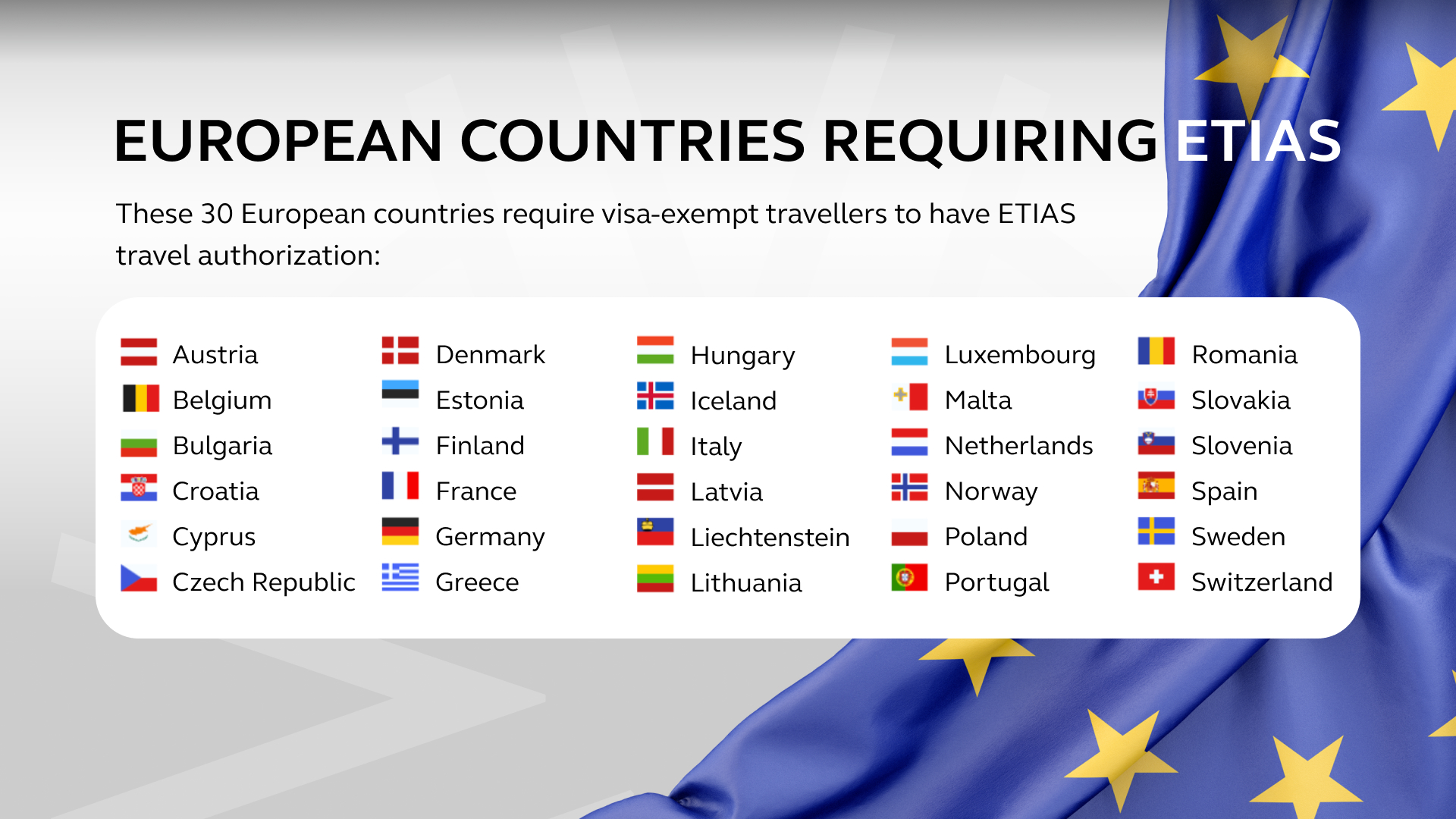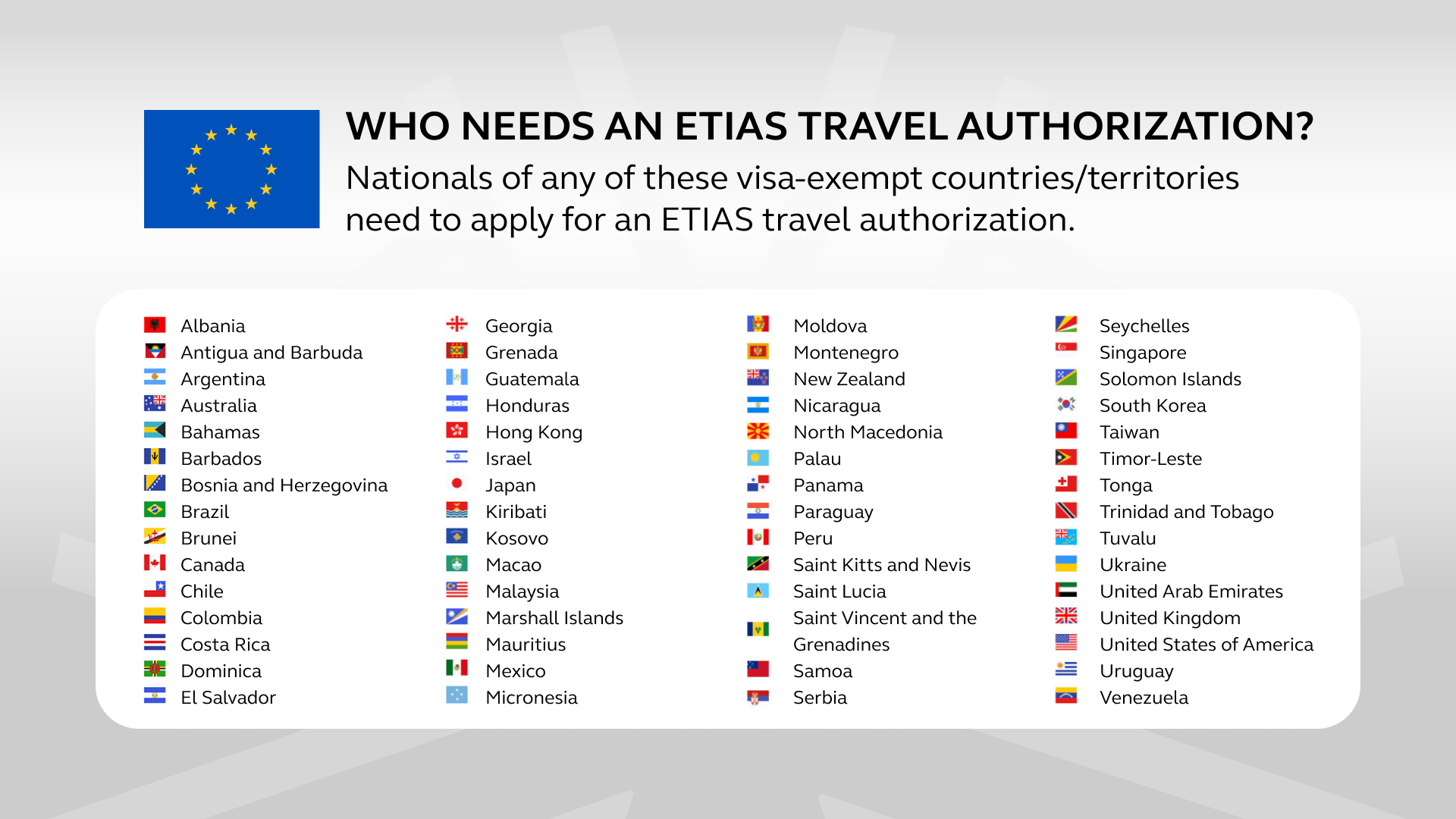The EU will implement a new electronic travel authorization system called ETIAS (European Travel Information and Authorization System) by mid-2025 to screen travelers prior to permitting them entry into 30 EU countries.
The EU has repeatedly delayed the launch of ETIAS for years, but it now has entered the final stretch.
While technological or operational issues have been cited as the main reason for ETIAS’ delays, others assume that political matters have contributed to the frequent postponements.
Whatever the case, ETIAS is now closer than ever, and it is crucial to understand its impact.
As countries like Spain, Germany, Italy, and France represent the most popular tourist destinations in the world, questions loom about how ETIAS will change travel plans or access to the EU.
Astons’ experts will demystify ETIAS, discuss its latest updates, and explore its implications for international travelers, especially from the US, UK, Canada, New Zealand, and Australia.
What is ETIAS?
Though the EU is funding massive marketing campaigns to thwart the idea that ETIAS is an eVisa, that is essentially exactly what ETIAS is.
The ETIAS system is a pre-travel screening mechanism designed to either approve or disapprove whether an individual is permitted to enter any of the 29 member countries of the Schengen Area or Cyprus. The ETIAS system will be paired with the EU’s new Entry/Exit System.
Note: Though not currently in the Schengen Zone, Cyprus has begun the process of joining the Schengen Zone with the goal of completing the process and fully joining the Schengen Zone by the end of 2024 – thus Cyprus is included in the ETIAS program
Modeled after the well-established and restrictive US-ESTA [Electronic System for Travel Authorization], which is required for travelers wishing to visit the United States, ETIAS will mandate that visa-exempt third-country nationals obtain prior authorization before they can enter any of the 30 European countries.
The EU’s stated primary objective of ETIAS is to identify potential security risks and threats posed by travelers from visa-exempt countries before they reach the external borders of the Schengen Zone.
However, several EU sources have claimed that ETIAS is a response to the US’s continued refusal to exempt EU citizens from the US-ESTA requirement.
Once implemented, travelers from over 60 visa-exempt countries, including the United States, United Kingdom, Canada, Australia, and New Zealand, will require ETIAS authorization or be denied entry at the Schengen Zone border.
What is EES?
Launching before ETIAS, the European Union is also implementing a new Entry/Exit System [EES] to enhance the efficiency of ETIAS and providing real-time data of who is on EU soil and whether they overstay their 90-days.
Expected to be active by October 2024 at some EU borders, the EES will require all non-EU citizens and residents to submit fingerprints and a have their faces scanned at the border.
The EES will replace the old fashioned passport stamp, as the system will record the:
- Identity information
- Type of travel document
- Biometric data
- Date and place of entry
- Date and place of exit
of every third-country national that enters the EU. The system is designed to hold the data for three years from the date of exiting the EU and then erase it.
While there will be some overlap to the reach of the EES and ETIAS systems, they will not overlap completely.
As ETIAS is designed for the Schengen Zone, the EES is specific to the EU – so all EU countries will require EES biometrics at the border except Cyprus and Ireland.
The following non-EU countries will not require EES even though they are in the Schengen Zone and will require ETIAS:
- Norway
- Iceland
- Switzerland
- Liechtenstein
The French border for entry from the UK into the EU is schedule to be the first EES point to be activated by October 2024.
Like ETIAS, EES will only apply to third-country nationals – Portugal, Greece, and Hungary Golden Visa holders will not be required to submit their fingerprints or have their faces scanned at the border.
What is the Schengen Zone?
The Schengen Zone is the borderless region within the European Union that allows for freedom of movement and travel from one EU country to another EU country without the need to go through customs or passport controls.
The Schengen Zone operates exactly like travel within the United States. Once in the United States, travel from one state to another is completely open and unrestricted.
Elevate that same freedom of movement to an international level – that is the EU’s Schengen Zone, one of the greatest achievements in the history of human rights.
Currently, the Schengen Zone includes 29 European countries; however, though Cyprus is an EU country, it is not yet in the Schengen Zone – but as it is expected to become a member of the Zone by the end of 2024, entry to Cyprus will be included in ETIAS.
ETIAS will be required for the following 30 countries:
Who will be required to get ETIAS approval?
Nothing will change for travelers currently required to have a Schengen Visa [or any visa] to enter any of the 30 countries covered by ETIAS.
Those travelers will still require the same visa they require now, and thus, they will not need ETIAS as their entry has already been approved through the visa process.
Furthermore, for those travelers, ETIAS will not be a substitute or an option. Travelers who, in 2024, require a visa to enter any of the ETIAS-covered countries will continue to be subject to the same visa requirements after the launch of ETIAS.
The only change will be for travelers who currently enjoy the privilege of entering any of the above-listed countries without a visa.
It should be noted that ETIAS will not replace any existing visa requirements that extend beyond the standard 90-day visa-free entry -such as visas for employment, research, education, etc.
All visas will continue to be required – ETIAS will be required when no other visa is needed by the traveler.
How will the ETIAS system operate?
The authorization process is expected to be straightforward.
Affected travelers who intend to travel to any of the 30 covered countries will go to the ETIAS website and navigate through the application form question by question.
Most applicants handle the entire process in one go and have their applications processed within minutes. However, an official response—either entry is approved or disapproved—could take up to four days.
Furthermore, results can take up to 14 days if immigration officials decide they want additional documents and up to 30 days if immigration officials want to interview the applicant prior to making a decision.
The ETIAS system, to determine entry eligibility, will cross-check an applicant’s information against various databases, including:
- Interpol’s Stolen and Lost Travel Documents (SLTD) database
- EUROPOL
- All national criminal, security, and intelligence databases
- All publicly accessible databases
- All relevant international watchlists
If approved, ETIAS authorization is valid for an unlimited number of entries into the Schengen Zone for three years or until the expiration date of the traveler’s passport, whichever comes first.
If ETIAS denies an application, applicants will receive an email explaining why their application was rejected and instructions on how to appeal the decision.
For those receiving ETIAS approval, the current 90 days in/90 days out rule is unchanged.
Travelers with ETIAS approval will still be permitted in one or any combination of the 30 countries for a total of 90 days, beginning on the day of their first entry. Exiting during the 90 days does not restart the clock.
Once the 90-day period expires, ETIAS-approved travelers will be required to exit and remain outside all 30 countries for at least the next 90 days.
Then, the 90-day cycle restarts.
Transforming the European Union from destination to status
The launch of ETIAS will transform the ability to freely enter the European Union as one wishes to a select privilege only held by EU citizens and residents.
ETIAS is purpose-built to streamline and harmonize the entry procedures for visa-exempt travelers across the 30 covered countries so that they are more aligned with the requirements for visa-requiring travelers.
Of course, the EU states that ETIAS is expected to enhance border control processes by enabling authorities to conduct risk assessments and gather traveler information well in advance of their arrival.
A proactive approach that aims to facilitate smoother and more efficient border crossings, reducing potential bottlenecks and delays at ports of entry.
However, that makes little sense, as ETIAS approval will now need to be verified instead of simply scanning passports to approve entry.
The EU is implementing ETIAS as both an additional screening layer—enabling authorities to detect potential risks and threats before they materialize—and a real-time database to determine who is on EU soil but doesn’t have the inherent right to be there.
Who will be exempt from ETIAS?
The summer of 2024 marks the final visa-free tourist season in the European Union for all third-country nationals.
Once ETIAS is launched in 2025, only EU citizens and individuals with legal residency in an EU country will be exempt from the ETIAS requirements.
ETIAS exemption is now included in all EU Golden Visa programs, specifically:
This means that investors, entrepreneurs, and families who possess one of the above EU Golden Visas will have the right to enter the EU freely without needing to be concerned with ETIAS approval.
Astons – Clients with status and privilege
As the European Union prepares to implement ETIAS, it is crucial for global investors and entrepreneurs to stay informed and adapt to the new requirements as well as any new deadlines that may occur.
With the advent of ETIAS on the horizon, many countries are seizing the opportunity to update their Golden Visa programs to benefit only a far more selective clientele, as now those programs provide ETIAS exemption.
In 2023, Portugal eliminated the real estate option from its program and replaced it with the Portugal Golden Visa Equity Fund option, which has become one of the most popular Golden Visa investment options for US and UK investors.
On 31 March 2024, Greece increased the price tiers of the Greek Golden Visa program from €250K & €500K to €400K & €800K and changed the investment zones. Athens went from having both €250K & €500K options to only €800K.
However, investors have until 31 August 2024 to keep the old price tiers and investment zones and still acquire ETIAS exemption.
Spain has announced that it is terminating its Golden Visa program, while Hungary announced it will re-launch its program—expected by July 2024.
Cyprus, which is currently not in the Schengen Zone, is targeting full accession to the Schengen Zone by the end of 2024. This will increase the overall value of Cypriot residency, which can currently be acquired via the Cyprus Golden Visa for only €300K.
However, only time will tell if Cyprus follows in the footsteps of Greece with a price increase after joining the Schengen Zone.
The introduction of ETIAS will alter the global paradigm of the freedom of movement for many individuals, but it will have no impact at all on those who hold an EU Golden Visa or possess EU citizenship.
Investors, entrepreneurs, and families who seek to keep that level of privilege and status, schedule a Free Confidential and Comprehensive Consultation with Astons today and our experts will examine your individual situation and connect you with the program options that satisfy everything you need.
















